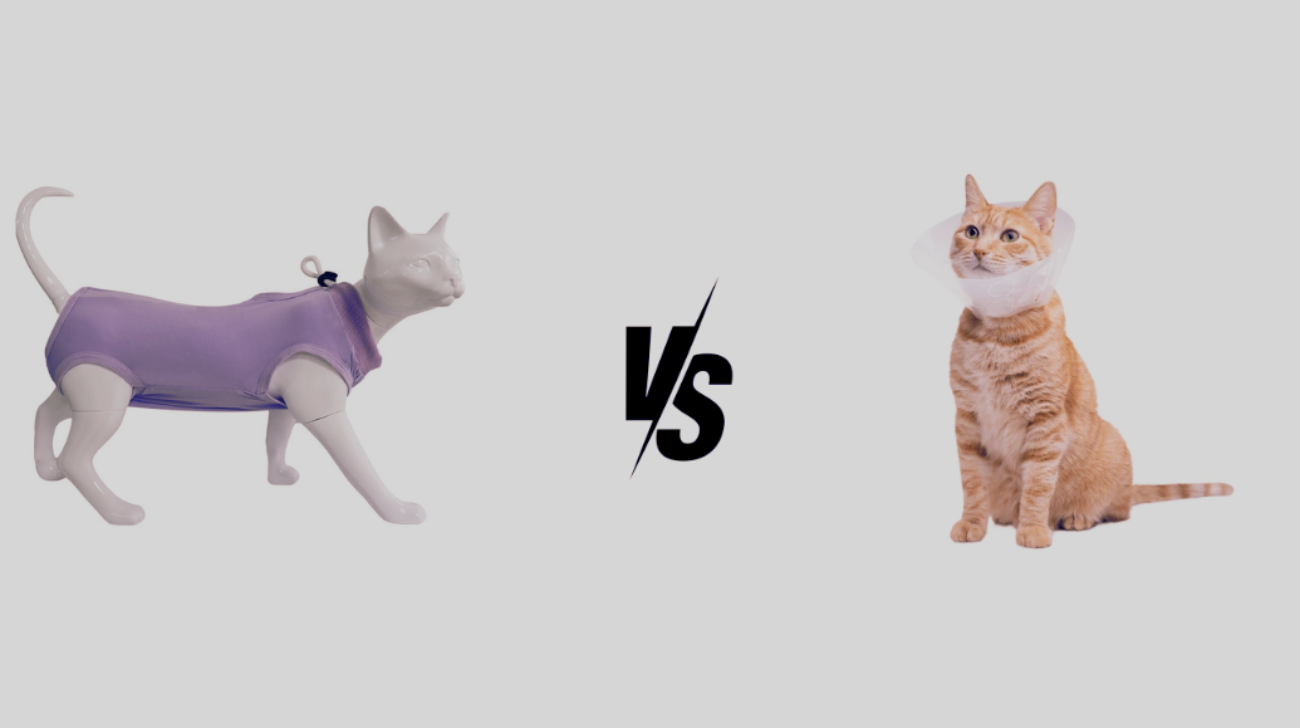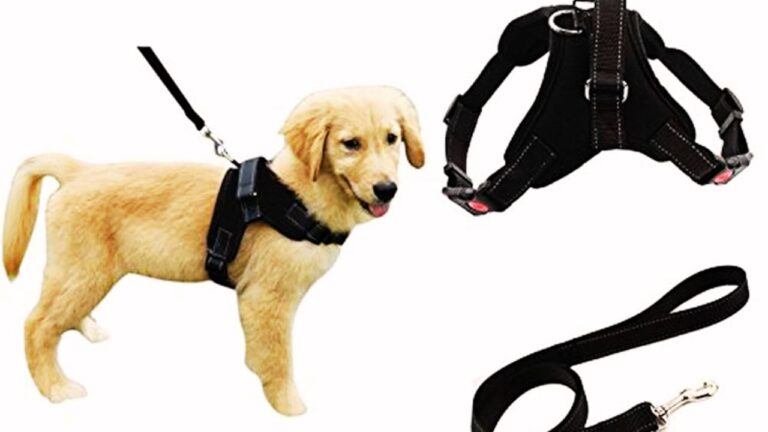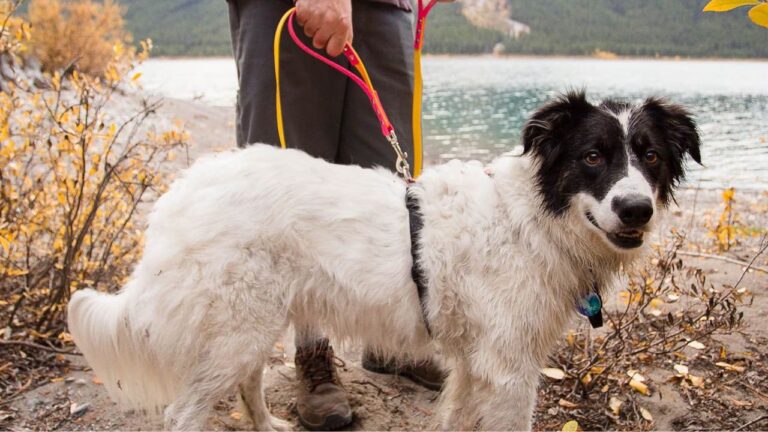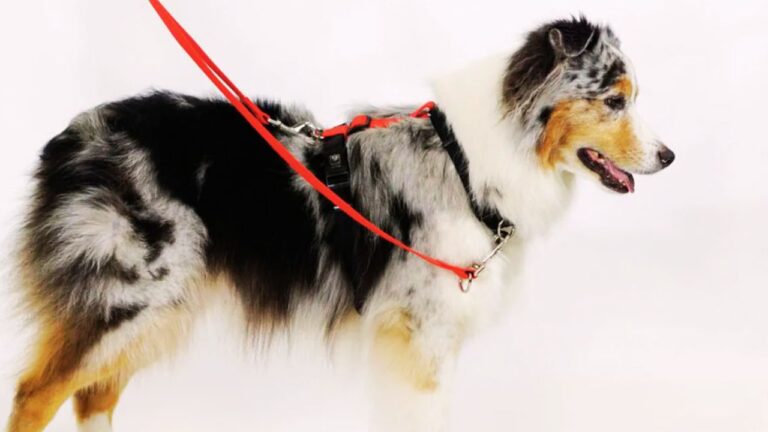When your cat undergoes surgery, injury, or skin issues, keeping them from licking, biting, or scratching the affected areas becomes crucial. Traditionally, pet owners have relied on the cone collar (often referred to as the Elizabethan collar or E-collar) to prevent such behavior.
However, newer alternatives like the recovery suit have gained popularity due to their comfort and functionality. The recovery suit vs cone cat debate focuses on which option offers the best solution for post-surgery recovery and skin protection.
Both the recovery suit and cone collar serve similar purposes, but their design, comfort, and effectiveness vary significantly. I will explore the differences, pros, and cons of each product, and help you determine which one is more suitable for your cat’s specific needs. Learn about the size collar for an American Eskimo to ensure a perfect fit and comfort for your dog.
Blog Highlights
ToggleMy Personal Opinion
As a cat owner who has experienced both the recovery suit vs cone cat collar, I can confidently say that both options have their merits. The cone collar, while effective, can be quite restrictive, uncomfortable, and cumbersome for cats. It’s a classic solution, but many cats struggle to adapt to the awkwardness it causes.
The recovery suit, on the other hand, offers a more comfortable and natural alternative. It allows cats to move freely without the encumbrance of a plastic cone, while still protecting their wounds or surgical sites.
However, I do believe that the choice depends on your cat’s temperament, the type of recovery they require, and their ability to tolerate the products. Some cats may find the recovery suit more comfortable, while others might adapt better to the traditional cone.
What is a Recovery Suit for Cats?
A recovery suit for cats is a type of protective garment designed to cover your pet’s body and prevent them from licking or scratching wounds, stitches, or irritated skin. The suit is usually made from soft, stretchy, and breathable fabric, and it fits snugly around your cat’s torso.

Unlike the cone collar, which only restricts access to the head and neck, a recovery suit provides full-body coverage. Discover why Afghan Hound collars are wide by exploring the unique characteristics of this breed and how wide collars enhance their comfort and style.
Key Features of the Recovery Suit
- Full-Body Coverage: Recovery suits cover the entire body, including the legs and abdomen. This ensures that your cat cannot access surgical wounds or irritated areas anywhere on their body, not just around the head or neck.
- Comfortable and Flexible: Made from soft and stretchy fabric, recovery suits are designed to allow freedom of movement. Cats can walk, sleep, and groom themselves normally, except for the areas that need to be protected.
- Breathable Materials: Many recovery suits are made from cotton or other breathable materials that help to prevent overheating and ensure comfort, even for prolonged periods.
- Adjustable Fit: Most recovery suits come with adjustable straps to ensure a snug but comfortable fit around your cat’s body. This customization helps prevent the suit from slipping off or becoming too tight.
- Ease of Use: The recovery suit is easy to put on and take off. Many models feature Velcro or other simple fastenings, allowing pet owners to dress their cats without much hassle.
- Machine Washable: Recovery suits are often machine washable, making them easy to clean after use.
What is a Cone Collar for Cats?
A cone collar, also known as an Elizabethan collar or E-collar, is a plastic cone that fits around a cat’s neck. It is designed to prevent the cat from licking, biting, or scratching wounds, stitches, or irritated skin.

The collar usually attaches around the neck and extends outward to form a cone shape, which limits the cat’s ability to reach its head and body. Find out what style dog collar is best for hounds to ensure comfort and safety for your furry friend.
Key Features of the Cone Collar
- Head and Neck Protection: The cone collar is effective at preventing cats from licking or biting wounds on their face, neck, or upper body. However, it may not prevent the cat from accessing wounds on other parts of the body.
- Rigid Design: Made from plastic or other sturdy materials, the cone collar is rigid and extends outward, restricting the cat’s ability to see and interact with its environment comfortably.
- Variety of Sizes: Cone collars come in various sizes to accommodate different breeds and neck circumferences. It is important to choose the right size to ensure that the collar fits snugly around your cat’s neck without causing discomfort or chafing.
- Discomfort and Restriction: One of the major drawbacks of cone collars is their discomfort. Cats may feel disoriented or frustrated by the restricted movement, especially when trying to eat, drink, or groom themselves.
- Durability: The rigid structure of the cone collar makes it durable, but it can be bulky and may cause difficulties in daily activities like walking through doorways or navigating tight spaces.
- Variety of Materials: Cone collars can come in different materials, such as plastic, fabric, or soft materials like inflatable cones. Each offers a different level of comfort and flexibility.
Recovery Suit vs Cone Cat Collar: Key Differences
While both the recovery suit and cone collar are designed to prevent your cat from licking or scratching wounds, there are several key differences between the two options. Let’s explore them in more detail. The recommended size collar for an English Cocker Spaniel usually ranges from 12 to 18 inches, providing a snug and comfortable fit for your dog.
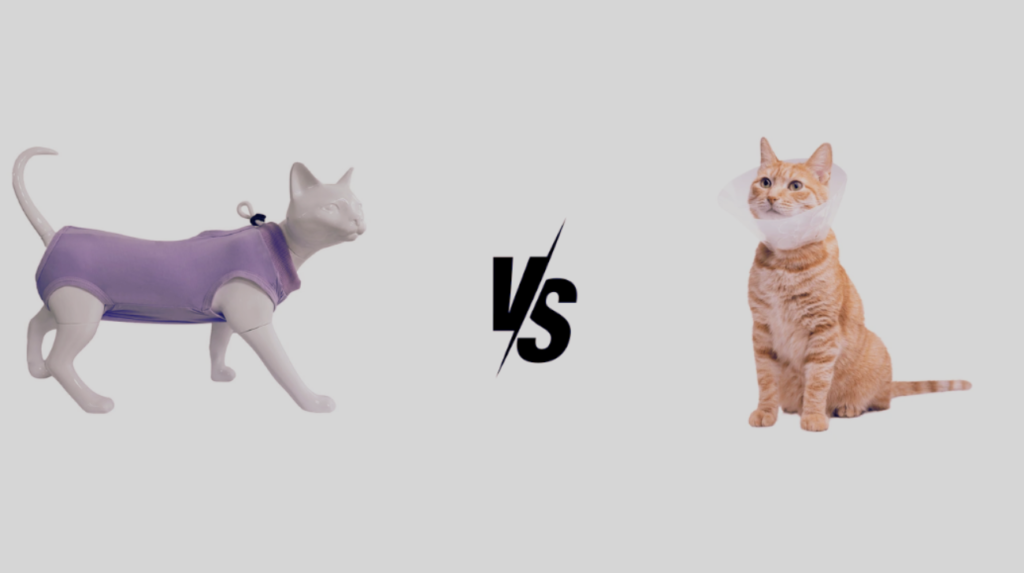
1. Comfort and Mobility
Recovery Suit: Comfortable and Flexible
The recovery suit is designed for comfort. It is made of soft, stretchy materials that allow your cat to move freely. Unlike the cone collar, which restricts your cat’s head and neck movement, the recovery suit provides full-body coverage, but does not impede regular movements.
Your cat can eat, drink, and sleep comfortably, and it allows for natural body movements, including stretching and grooming (except for the protected areas). To find the perfect fit, learn more about what size collar for a Bichon, ensuring your dog’s comfort and safety.
This level of comfort is crucial for cats that are sensitive to discomfort, as they may experience stress or anxiety with the bulky and restrictive cone collar. Cats that have undergone surgery or are recovering from an injury will appreciate the freedom of movement offered by the recovery suit.
Cone Collar: Restrictive and Uncomfortable
The cone collar, on the other hand, is known for its discomfort. The rigid, plastic cone can make it difficult for cats to eat, drink, and sleep. It can also make it challenging for them to navigate their surroundings, as the cone can bump into walls, furniture, or doors. Many cats find the cone collar restrictive and frustrating, which can lead to stress or anxiety.
Cats are not accustomed to having their vision blocked or restricted, and the cone’s design can impair their ability to groom themselves, which may lead to further discomfort.
2. Effectiveness in Preventing Licking and Biting

Recovery Suit: Full-Body Coverage
The recovery suit is highly effective at preventing your cat from licking or biting wounds, particularly when the injury or surgery is located on the abdomen, legs, or sides. Because it covers a larger area of the body, it offers more comprehensive protection compared to the cone collar, which only limits access to the head and neck.
Cats that have undergone abdominal surgery or have skin irritations on their torso will benefit from the full-body coverage of the recovery suit. It also provides an extra layer of protection against external irritants like dirt or debris.
Discover the ideal option by exploring what is the best collar material for a Bichon Frise to ensure your pet’s comfort and durability.
Cone Collar: Focused Protection
While the cone collar effectively prevents cats from licking or biting wounds around the head, neck, or upper body, it is less effective at preventing licking or scratching on other parts of the body. If your cat has an injury on its legs or abdomen, a cone collar alone may not be enough to prevent them from accessing the wound.
The cone collar’s focused protection is ideal for preventing licking or biting around the face and neck but is not as versatile as the recovery suit.
3. Ease of Use and Comfort for the Cat
Recovery Suit: Easy to Wear and Comfortable
The recovery suit is typically easy to put on and remove. Most models have adjustable straps or Velcro closures, making them simple to fit around your cat’s body. Because the suit is soft and flexible, your cat is likely to adjust to wearing it more quickly compared to the cone collar.
Moreover, the suit does not interfere with your cat’s daily activities, such as eating, drinking, or using the litter box. It is a great option for cats who may feel stressed or anxious in restrictive environments.
Cone Collar: Difficult to Wear and Awkward
The cone collar, although effective, can be challenging for cats to adjust to. It may take time for them to get used to the sensation of having something around their neck, and many cats will struggle to eat, drink, and groom themselves with the cone in place. Additionally, the cone collar often makes cats feel disoriented or clumsy, leading to frustration.
Some cats may also attempt to remove the cone, either by trying to paw it off or by attempting to squeeze out of it, especially if it is not fitted correctly. The best collar size for an American Staffordshire Terrier ensures a comfortable and secure fit for your dog during walks and training.
4. Aesthetic and Appeal

Recovery Suit: Sleek and Stylish
The recovery suit tends to be more aesthetically pleasing. Many models come in different colors and designs, allowing pet owners to choose a suit that fits their cat’s personality or even a suit that coordinates with their own wardrobe. The recovery suit’s sleek design also helps cats feel less self-conscious compared to wearing the bulky, often unattractive cone collar.
Cone Collar: Functional but Unattractive
The cone collar, while functional, is not known for its aesthetic appeal. The cone is bulky and often perceived as unsightly. Many pet owners feel that their cats look more stressed and uncomfortable when wearing the cone, and it can be a source of embarrassment for both the cat and the owner.
5. Price Range
Price is an important consideration when choosing between the recovery suit and the cone collar. Check out the best dog collars for Border Collie to find durable, stylish, and comfortable options for your active dog.
Recovery Suit: Moderately Priced
A recovery suit typically costs between $20 to $40, depending on the brand, size, and features. The suit’s affordability, combined with its comfort and effectiveness, makes it a popular choice for many pet owners.
Cone Collar: Budget-Friendly
The cone collar is generally more affordable, with prices ranging from $10 to $20. While cheaper than the recovery suit, the cone collar’s limitations in comfort and flexibility may make it a less desirable option for some pet owners.
Recovery Suit vs Cone Collar: Comparison Table
| Feature | Recovery Suit | Cone Collar |
| Coverage | Full-body coverage | Head and neck only |
| Comfort | Soft, flexible, breathable | Rigid, restrictive, uncomfortable |
| Effectiveness | Highly effective for all wounds | Effective for head and neck wounds |
| Ease of Use | Easy to wear and adjust | Difficult to wear, awkward for cats |
| Aesthetic | Sleek and stylish | Bulky and unattractive |
| Price | $20 to $40 | $10 to $20 |
| Wearing Time | Long periods of comfort | Shorter periods due to discomfort |
| Cleaning | Machine washable | Easy to clean, but not washable |
Conclusion: Recovery Suit vs Cone Collar – Which One Should You Choose?
Choosing between a recovery suit vs cone cat collar ultimately depends on your cat’s needs, personality, and recovery type. If your cat needs full-body protection from licking and scratching, the recovery suit is the better option.
It provides comfort, flexibility, and a more natural recovery process, allowing your cat to move freely while still being protected. For guidance on choosing the right collar size for an Airedale puppy, check out this detailed guide.
If your cat only needs protection around the head or neck, or if you’re looking for a more affordable, traditional solution, the cone collar may be the right choice. While it may be uncomfortable and restrict your cat’s movement, it remains a tried-and-true method for wound and injury management.
Ultimately, the decision comes down to your cat’s unique circumstances. Whichever you choose, make sure the product you select is suitable for your cat’s comfort and recovery process, and always follow your veterinarian’s recommendations for post-surgical care.

